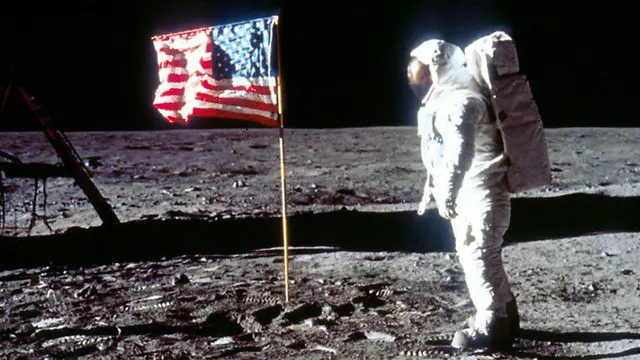The US says it will put astronauts back on the moon within five years by any means necessary.
NASA carried out six manned flights to earth's satellite between 1969 and 1972.
Fears that the US may be falling behind in the space race and president Trump's desire for a flagship project to champion as he mounts a re-election bid are thought to be behind the acceleration of the project to send Americans back to the moon.
The US military is also wary of potential space weaponry capabilities of rival superpowers Russia and China. Both countries have landed unmanned craft on the moon.
NASA had originally planned a manned mission by 2028, after first putting a gateway station in orbit around the moon by 2024.
Announcing the new timetable at a meeting of the National Space Council in Alabama, vice president Mike Pence said: We're in a space race today, just as we were in the 1960s.
Image:Neil Armstrong was the first man to walk on the moon
And in a nod to the words of Neil Armstrong, the first man on the moon, he added: It's time for the next giant leap.
That next giant leap is to return American astronauts to the moon within the next five years by any means necessary, and to establish a permanent presence on the moon and prepare to put American astronauts on Mars.
He went on: In order to accomplish this, NASA must transform itself into a leaner, more accountable and more agile organisation.
That last comment is being viewed as a reference to the cost of the programme, likely to be tens of billions of dollars.
Since shuttle missions ended in 2011 NASA has struggled to devise a suitable project for human space launches from US soil.
Following Mr Pence's announcement NASA Administrator Jim Bridenstine said in a Twitter post: Challenge accepted. Now let's get to work.
Image:Space Launch System booster being tested
NASA, along with Boeing, is currently developing its its next big rocket and capsule vehicle - the Space Launch System, or SLS, designed to carry crews and cargo beyond Earth orbit.
It is also working with other companies such as SpaceX andr the Boeing-Lockheed Martin partnership United Launch Alliance, to get an uncrewed capsule into space by 2020.
In November, NASA named nine US firms, including Lockheed Martin Corp, that would compete for funding under the space agency's renewed private-public partnership for developing technology to explore the lunar surface.
(SKY NEWS)
 简体中文
简体中文

